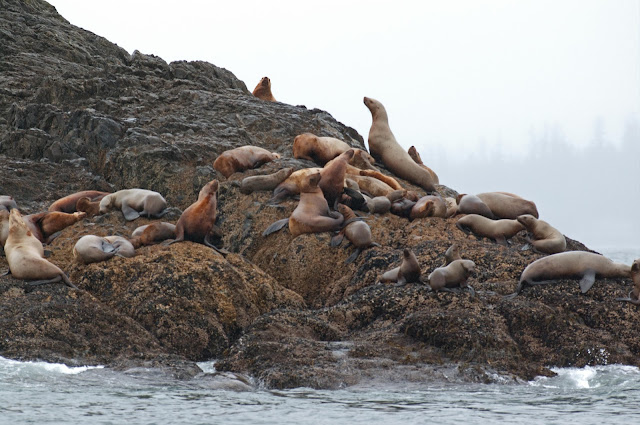 |
| View of Okanagan Lake and Kelowna from the Chute Lake Road |
North of Vernon, we stopped at Swan Lake to look for Black
Swifts but it was the wrong time of day.
Our last stop was at the Salmon Arm harbour. Dick Cannings mentioned that there were
usually Clark’s Grebes in amongst the large number of Western Grebes. He was right (not that we doubted you, Dick!)
and three of us had great looks at a pair of displaying birds.
 |
| Clark's Grebes |
Phil was a bit under the weather so he had only a brief look
and then went back to the car to rest. We
then drove straight through to Calgary as we wanted to get Phil into the loving
care of his wife as soon as possible. Our decision to forgo any subsequent
stops was made easier as we determined that there were no likely new team species
on the rest of the route.
Looking back, we had another great trip. Though the weather was a little on the wet side
on Vancouver Island, we managed to see most our target species while enjoying
the rugged beauty of the coastal landscape.
 |
| View from our Tofino area motel |
 |
| Totem in Pacific Rim N.P. |
We finally made inroads on our mammal count, mostly with marine mammals and rodents.
The highlight was undoubtedly the Vancouver Island Marmot. Phil obtained good information about the
animal’s location but some knowledgeable people gave us little chance of finding it.
We did a whale watching trip, enjoying close
up views of a Gray Whale and Steller’s Sea Lions. Viewing the Gray Whale was always in parts –
first you’d see the spout (though it was more of a fine mist by the time I got
the camera on it), then the barnacle encrusted back would come into view and
finally the tail flukes just as it dove.
 |
| Phil, Brian and Mike on board whale watching boat |
 |
| Three sections of a Gray Whale - spout, tail and back |
Southwest BC has a number of mammals that cannot be found
elsewhere in Canada and we had hoped to see at least a couple of them. It was disappointing not to be able to get to
the habitat of Cascade Golden-mantled Ground Squirrel and Townsend’s Chipmunk because
of road closures in Manning Park but we did spot the Douglas’s Squirrel a
couple of times.
 |
| Douglas's Squirrel |
On this trip, the focus shifted from migrant to breeding
birds. On the west coast, the birding
was more difficult than we were used to – the trees are so tall making the tree-top birds tough to see, the wet stuff
falling from the sky blurred the binoculars and the west coast accents of some species confused us at
times. For instance, Townsend’s Warbler sounds
much different than here in Alberta. Still,
we managed to get almost all of our non-pelagic targets. We thought we might see some near-shore pelagics but the whale watching boat headed south instead of the birdier north.
Thanks to a fortuitous meeting with David Routledge,
watching Vaux’s Swifts go to roost in a Cumberland chimney was a real
treat. Though we are not chasing rare
birds, it is always nice when one shows up when we are in the area. We were lucky that an Acorn Woodpecker visiting
a feeder near Hope stayed around for a few days.
 |
| Acorn Woodpecker |
 |
| Birding along the Okanagan River north of Vaseux Lake |
On the BC trip we recorded 187 birds and 23 mammals; more
importantly, we had 30 new birds and 11 mammals. Our year’s total now stands at 405 – 360 birds
and 45 mammals. In the next few weeks, we have trips to the
Yukon & Northwest Territories and the east coast as well as some Alberta
excursions. We think that we our target of 500 is attainable (but won’t be
easy) and will have a better idea of where we stand by mid-July. Getting a few bat species would greatly
improve our chances … anyone know of any bat roosts in Alberta or on the east
coast?









































.jpg)